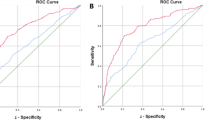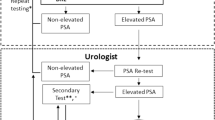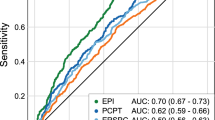Abstract
The aim of the study was to assess the utility of prostate-specific antigen (PSA) as a predictor of prostate volume indexes (total prostate volume (TPV), transition zone volume and transition zone index) in Korean men with lower urinary tract symptoms (LUTS). From September 2003 to April 2006, 3431 patients with LUTS were included in the study; they had a median age of 63.8 years, a median prostate volume of 22.6 ml and a median serum PSA of 1.04 ng/ml. Men with a baseline PSA of >10 ng/ml were excluded, to reduce the likelihood of including occult prostate cancer. Prostate volume indexes and serum PSA levels had an age-dependent log-linear relationship. Receiver operating characteristic curve analysis showed that PSA had good predictive value for various prostate volume indexes thresholds. The approximate age-specific criteria for detecting men with a TPV of >40 ml are PSA levels of 1.20, 1.44 and 1.72 ng/ml for men with LUTS in their sixth, seventh and eighth decades, respectively. The results show that serum PSA identifies Korean men with large prostates reasonably well. Korean men may produce and/or release more PSA per unit prostate volume than white men. The cutoffs for PSA and prostate volume to response to LUTS therapy should be determined in this population.
This is a preview of subscription content, access via your institution
Access options
Subscribe to this journal
Receive 4 print issues and online access
$259.00 per year
only $64.75 per issue
Buy this article
- Purchase on Springer Link
- Instant access to full article PDF
Prices may be subject to local taxes which are calculated during checkout


Similar content being viewed by others
References
Boyle P, Gould AL, Roehrborn CG . Prostate volume predicts outcome of treatment of benign prostatic hyperplasia with finasteride: meta-analysis of randomized clinical trials. Urology 1996; 48: 398–405.
Jacobsen SJ, Jacobsen DJ, Girman CJ, Roberts RO, Rhodes T, Guess HA et al. Natural history of prostatism: risk factors for acute urinary retention. J Urol 1997; 158: 481–487.
Roehrborn CG, McConnell JD, Lieber M, Kaplan S, Geller J, Malek GH et al. Serum prostate-specific antigen concentration is a powerful predictor of acute urinary retention and need for surgery in men with clinical benign prostatic hyperplasia. PLESS Study Group. Urology 1999; 53: 473–480.
McConnell JD, Bruskewitz R, Walsh P, Andriole G, Lieber M, Holtgrewe HL et al. The effect of finasteride on the risk of acute urinary retention and the need for surgical treatment among men with benign prostatic hyperplasia. Finasteride Long-Term Efficacy and Safety Study Group. N Engl J Med 1998; 338: 557–563.
Hong SJ, Ko WJ, Kim SI, Chung BH . Identification of baseline clinical factors which predict medical treatment failure of benign prostatic hyperplasia: an observational cohort study. Eur Urol 2003; 44: 94–99.
Roehrborn CG, Boyle P, Gould AL, Waldstreicher J . Serum prostate-specific antigen as a predictor of prostate volume in men with benign prostatic hyperplasia. Urology 1999; 53: 581–589.
Wilde MI, Goa KL . Finasteride: an update of its use in the management of symptomatic benign prostatic hyperplasia. Drugs 1999; 57: 557–581.
Roehrborn CG, Girman CJ, Rhodes T, Hanson KA, Collins GN, Sech SM et al. Correlation between prostate size estimated by digital rectal examination and measured by transrectal ultrasound. Urology 1997; 49: 548–557.
Ochiai A, Fritsche HA, Babaian RJ . Influence of anthropometric measurements, age, and prostate volume on prostate-specific antigen levels in men with a low risk of prostate cancer. Urology 2005; 66: 819–823.
Mochtar CA, Kiemeney LA, van Riemsdijk MM, Barnett GS, Laguna MP, Debruyne FM et al. Prostate-specific antigen as an estimator of prostate volume in the management of patients with symptomatic benign prostatic hyperplasia. Eur Urol 2003; 44: 695–700.
Rietbergen JB, Kranse R, Hoedemaeker RF, Kruger AE, Bangma CH, Kirkels WJ et al. Comparison of prostate-specific antigen corrected for total prostate volume and transition zone volume in a population-based screening study. Urology 1998; 52: 237–246.
Morote J, Encabo G, Lopez M, de Torres IM . Prediction of prostate volume based on total and free serum prostate-specific antigen: is it reliable? Eur Urol 2000; 38: 91–95.
Hedelin H, Johansson N, Stroberg P . Relationship between benign prostatic hyperplasia and lower urinary tract symptoms and correlation between prostate volume and serum prostate-specific antigen in clinical routine. Scand J Urol Nephrol 2005; 39: 154–159.
Gupta A, Aragaki C, Gotoh M, Masumori N, Ohshima S, Tsukamoto T et al. Relationship between prostate specific antigen and indexes of prostate volume in Japanese men. J Urol 2005; 173: 503–506.
Aoki Y, Arai Y, Maeda H, Okubo K, Shinohara K . Racial differences in cellular composition of benign prostatic hyperplasia. Prostate 2001; 49: 243–250.
Chung BH, Hong SJ, Cho JS, Seong DH . Relationship between serum prostate-specific antigen and prostate volume in Korean men with benign prostatic hyperplasia: a multicentre study. BJU Int 2006; 97: 742–746.
Recker F, Kwiatkowski MK, Pettersson K, Piironen T, Lummen G, Huber A et al. Enhanced expression of prostate-specific antigen in the transition zone of the prostate. A characterization following prostatectomy for benign hyperplasia. Eur Urol 1998; 33: 549–555.
Lepor H, Wang B, Shapiro E . Relationship between prostatic epithelial volume and serum prostate-specific antigen levels. Urology 1994; 44: 199–205.
Hammerer PG, McNeal JE, Stamey TA . Correlation between serum prostate specific antigen levels and the volume of the individual glandular zones of the human prostate. J Urol 1995; 153: 111–114.
Choi J, Ikeguchi EF, Lee SW, Choi HY, Te AE, Kaplan SA . Is the higher prevalence of benign prostatic hyperplasia related to lower urinary tract symptoms in Korean men due to a high transition zone index? Eur Urol 2002; 42: 7–11.
Hong SJ, Ko WJ, Kim SI, Chung BH . Identification of baseline clinical factors which predict medical treatment failure of benign prostatic hyperplasia: an observational cohort study. Eur Urol 2003; 44: 94–99.
Author information
Authors and Affiliations
Corresponding author
Rights and permissions
About this article
Cite this article
Shim, H., Lee, J., Jung, T. et al. Serum prostate-specific antigen as a predictor of prostate volume in Korean men with lower urinary tract symptoms. Prostate Cancer Prostatic Dis 10, 143–148 (2007). https://doi.org/10.1038/sj.pcan.4500937
Received:
Revised:
Accepted:
Published:
Issue Date:
DOI: https://doi.org/10.1038/sj.pcan.4500937
Keywords
This article is cited by
-
An overview of prostate diseases and their characteristics specific to Asian men
Asian Journal of Andrology (2012)



